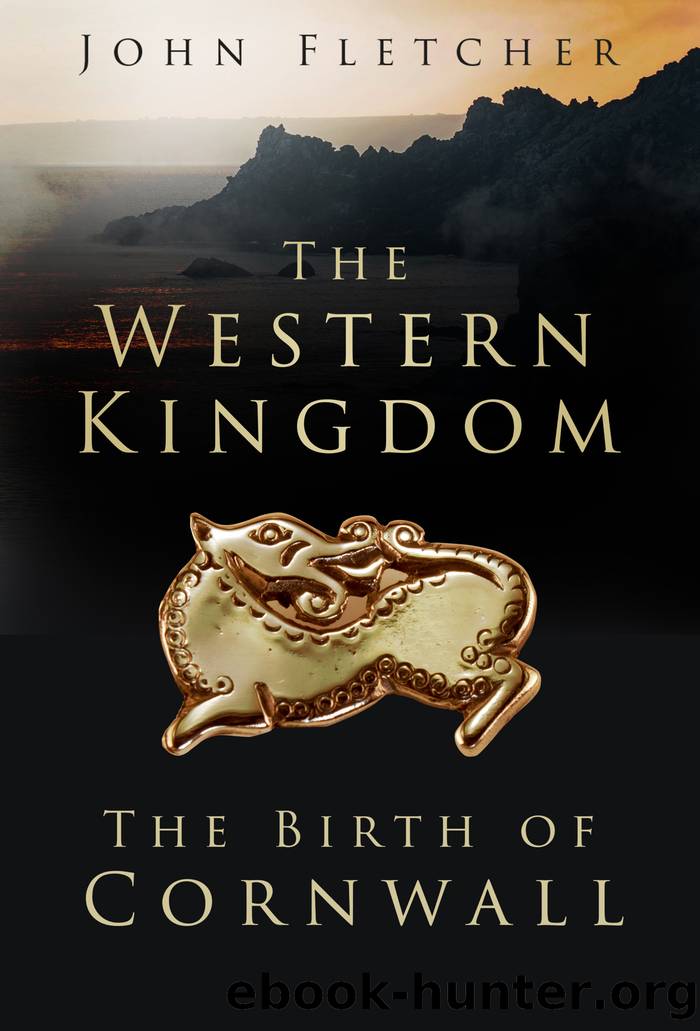The Western Kingdom: The Birth of Cornwall by John Fletcher

Author:John Fletcher [Fletcher, John]
Language: eng
Format: epub
Tags: History, Europe, Great Britain, Middle Ages (449-1066), General, Medieval
ISBN: 9781803991375
Google: NYlwEAAAQBAJ
Publisher: The History Press
Published: 2022-08-04T20:49:19+00:00
9
RULED BUT NOT CONQUERED: ADAPTATION AND SURVIVAL OF THE CORNISH IDENTITY
Following his victory at Hingston Down, Ecgberht seems to have had at least some hand in starting Anglo-Saxon settlement in north Cornwall. This potentially could be seen as a measure meant to protect the overland route between Devon and Cornwall so that a breakout, such as that which happened at Gafulford earlier in his rule, would not be repeated.
According to the records of Sherborne, he endowed the Church with holdings in Maker, âKelkâ and âRosâ. Both Kelk and Ros are more difficult to identify, although it is likely that Kelk relates to Kilkhampton (the English suffix becoming added as settlers arrived) in north Cornwall, reinforcing his interests there [Finberg, 1953]. Maker is obviously at the very far south of the border, just over the Tamar from Devon. However, it is likely in this case that either Ecgberht, or the Sherborne scribes, were attempting to reassert the claim of the Church over the parcel of land granted by King Geraint. Given the collapse of Dumnonia and the fierce fighting that followed, it seems extremely likely that any direct control of the site had long reverted to more local control. It may well be, with this in mind, that the estate at Ros relates to Rame Head close to Maker.
It would be tempting to see the grants at Maker as another response to learned experience, hopefully placing friendly eyes and ears at the mouth of the Tamar to warn of any new Viking fleets entering the river. This very southern outpost would perhaps have felt somewhat lonely, though in truth it was likely manned and managed by local Cornish people. The place-name evidence we have overwhelmingly supports a clustering of immigration in the northern half of the border region, with almost no Anglo-Saxon incursion further west than the River Lynher, itself only a short distance inland from the border at the Tamar.
If we compare place-name evidence for the northernmost âHundredâ of Cornwall, Stradneth, with the easternmost Hundred of Ryslegh, this pattern is made extremely clear. In Stradneth up to 90 per cent of the place names are either English or have English place name components in them, either a prefix or a suffix, while the density of English place names varies widely across Ryslegh, from as little as 40 per cent in the southernmost section up to 60 per cent in the central body of the region. However, the vast majority of the area is in the lower bracket for percentages [Finberg, 1953].
Of note is that this place-name evidence comes to us largely from modern sources, albeit with some items like the Domesday Book able to corroborate the names and their evolution. As such it represents the sum total of Saxon occupation throughout the remaining 200 or so years prior to the Norman conquest. The strong clustering in the northern area, combined with the previously noted tendency to avoid the coastal settlements, shows that the increasing population of Anglo-Saxons, or English speakers at any rate, were still very much on the outside of Cornish life and power.
Download
This site does not store any files on its server. We only index and link to content provided by other sites. Please contact the content providers to delete copyright contents if any and email us, we'll remove relevant links or contents immediately.
Cecilia; Or, Memoirs of an Heiress — Volume 1 by Fanny Burney(32503)
Cecilia; Or, Memoirs of an Heiress — Volume 2 by Fanny Burney(31913)
Cecilia; Or, Memoirs of an Heiress — Volume 3 by Fanny Burney(31900)
The Great Music City by Andrea Baker(31759)
We're Going to Need More Wine by Gabrielle Union(19004)
All the Missing Girls by Megan Miranda(15788)
Pimp by Iceberg Slim(14440)
Bombshells: Glamour Girls of a Lifetime by Sullivan Steve(14024)
For the Love of Europe by Rick Steves(13641)
Talking to Strangers by Malcolm Gladwell(13300)
Norse Mythology by Gaiman Neil(13284)
Fifty Shades Freed by E L James(13189)
Mindhunter: Inside the FBI's Elite Serial Crime Unit by John E. Douglas & Mark Olshaker(9266)
Crazy Rich Asians by Kevin Kwan(9225)
The Lost Art of Listening by Michael P. Nichols(7456)
Enlightenment Now: The Case for Reason, Science, Humanism, and Progress by Steven Pinker(7275)
The Four Agreements by Don Miguel Ruiz(6704)
Bad Blood by John Carreyrou(6586)
Weapons of Math Destruction by Cathy O'Neil(6221)
